THIS POST INCLUDES:
- Art Therapy and Illness
- About the Client
- Art Therapy Exercise
- Client Insight and Outcomes
- Disclaimer
- FREE DOWNLOAD Art Therapy Exercise
ART THERAPY AND ILLNESS
Dying from a terminal illness can have a significant impact on an individual’s mental health. Many mental health issues are common for those how are facing a terminal illness. Individuals facing a terminal illness may experience existential concerns related to their identity, purpose, and meaning in life. These concerns can lead to depression, anxiety, and a sense of despair.
Depression is a common mental health issue that can occur in individuals facing a terminal illness. This can be related to feelings of hopelessness, helplessness, and sadness related to the illness. Furthermore, anxiety can also be a common issue for individuals facing a terminal illness, as they may experience worry and fear related to the progression of the illness, pain management, and end-of-life concerns.
Individuals facing a terminal illness may experience traumatic events related to their illness, such as repeated hospitalizations or medical procedures. These experiences can lead to the development of PTSD symptoms such as flashbacks, avoidance, and hyperarousal.
The diagnosis of a terminal illness can be a significant stressor, leading to feelings of sadness, anxiety, and a sense of loss of control. These symptoms can develop into an adjustment disorder, which is characterized by an inability to cope with the stress of the diagnosis and its consequences.
Individuals facing a terminal illness may turn to substances such as alcohol or drugs as a way to cope with their illness or to manage physical pain. This can lead to the development of a substance use disorder.
It’s important to note that not everyone facing a terminal illness will experience these mental health issues, and each person’s experience will be unique. A mental health professional can work with individuals facing a terminal illness to identify and address any mental health concerns that may arise.
A THERAPIST’S ROLE
A therapist working with a client who has a terminal illness should prioritize creating a safe, compassionate, and supportive environment that acknowledges the client’s unique experience and offers space for them to express their feelings and thoughts.
Some of the issues that a therapist may discuss with a client who has a terminal illness include:
- Coping with grief and loss: Clients with a terminal illness may experience grief and loss as they face their own mortality, as well as the loss of future opportunities and dreams. A therapist can help clients explore their feelings of grief and loss and develop coping strategies that help them come to terms with the reality of their situation.
- Addressing fear and anxiety: Fear and anxiety can be common emotions for clients with a terminal illness. A therapist can help clients identify and manage their fears by using techniques such as cognitive-behavioral therapy, mindfulness, and relaxation techniques.
- Exploring spirituality and meaning: Clients may struggle with questions related to spirituality and meaning in the face of their terminal illness. A therapist can help clients explore these issues and find a sense of peace and meaning in their life.
- Managing physical symptoms: Clients with a terminal illness may experience physical symptoms such as pain, fatigue, and nausea. A therapist can work with the client to identify and manage these symptoms through a combination of medication and lifestyle modifications.
- Enhancing quality of life: A therapist can work with the client to develop a plan that focuses on enhancing their quality of life. This may include identifying meaningful activities, establishing social connections, and maintaining a sense of purpose.
- Discussing end-of-life issues: Clients may have concerns about end-of-life care, including how to communicate their wishes to loved ones and healthcare providers. A therapist can help clients explore these issues and work through any fears or concerns they may have.
It’s important to note that therapy should be tailored to the individual needs of the client, and the therapist should be flexible and responsive to the client’s unique situation. Ultimately, the therapist’s goal should be to provide support and guidance that helps the client achieve a sense of peace and dignity in their final months or years of life.
HOW ART THERAPY CAN HELP WITH A TERMINAL ILLNESS
Art therapy can be a helpful tool for individuals who are dying from a terminal illness by using the creative process of making art to improve a person’s physical, mental, and emotional well-being.
Art therapy can help individuals express emotions that may be difficult to verbalize. Making art can be a powerful way to communicate feelings such as sadness, anger, or fear. Additionally, art therapy can help individuals explore their thoughts and feelings in a nonverbal way. This can help them gain insight into their emotions and beliefs about their illness.
Engaging in a creative activity such as art-making can be a calming and relaxing experience. This can be especially helpful for individuals who are experiencing physical pain or anxiety related to their illness.
Individuals facing a terminal illness may feel a loss of control over their lives. Art therapy can provide a sense of control and empowerment by allowing individuals to make choices about their art-making process.
Art therapy can be done individually or in a group setting. Engaging in art-making with others can provide a sense of connection and community, which can be especially important for individuals who may be isolated due to their illness.
Creating art can provide a sense of legacy for individuals who are facing the end of their life. Artwork can be shared with loved ones and can serve as a tangible reminder of the individual’s life and experiences.
It’s important to note that art therapy is not a substitute for medical care, but can be a valuable complement to traditional medical treatment. A trained art therapist can work with individuals who are dying from a terminal illness to tailor art therapy interventions to their unique needs and goals.
Therapists should also be mindful of the impact of using specific art materials for each client. Some clients may have a sensitivity to smells and textures based on the medical treatment they are receiving or the physical issues they are experiencing. Furthermore, some clients may be bed bound based on their illness and therefore may need to participate in art making from their bed.
ABOUT THE CLIENT
- Name: Ekon
- Age: 40
CURRENT CLIENT ISSUES:
Ekon had been given a diagnosis of bowel cancer with 6 months to live. He was attending art therapy sessions provided within the hospital. Ekon felt consumed by the impending medical treatments and felt his physical symptoms were controlling his ability to think about other more important personal issues.
ART THERAPY EXERCISE
This art therapy exercise can help individuals who are worried about their illness to explore and express their emotions in a creative and nonverbal way.
INSTRUCTIONS:
- Ask your client to consider the illness they are experiencing in relation to the person they are that is experiencing this illness.
- Ask your client to create an artwork that gives perspective of how the illness looks, or is represented, in reference to themselves as a person.
- This perspective could be explored through the use of patterns, shapes, size, colours etc. The contrast of illness vs person can provide some insight into how the client views the impact of their illness on themselves.
CLIENT INSIGHT AND OUTCOMES
Prior to the art exercise, Ekon felt overwhelmed by his illness and felt that he was losing himself to all parts of the illness. Creating this artwork gave Ekon perspective on how he felt through creating a visual representation of his feelings.
Ekon felt creating this artwork gave him more power of his illness in that he was reminded that he was part of this process as a person.

DISCLAIMER
This case study represents a snapshot of the client’s progress in treatment. The exercise in this article could be used as written or as a guide for new and original tasks developed by the Art Therapist. Responsibility for treatment resides with the individual therapist who understands their clients specific needs. The art therapy exercise should not be viewed as a pre-defined directive on how to treat a client that presents with a specific range of problems.This art therapy exercise will help build a database of knowledge to draw upon when helping your client. Art Therapy is associated with psychotherapy techniques, however each therapist often approaches therapy with their own foundation of psychological interventions, whether it be psychotherapy, CBT, DBT or other methods.
FREE DOWNLOAD: Art Therapy Exercise
Download the FREE Art Therapy Exercise based on the above Case Study. The free download includes instructions for the art therapy exercise, along with an example of the art therapy exercise.

BUILD YOUR ART THERAPY REFERENCE MATERIALS:
Pin this image to your Pinterest board.

SHARE KNOWLEDGE & PASS IT ON:
If you’ve enjoyed this post, please share it on Facebook, Twitter, Pinterest. Thank you!
